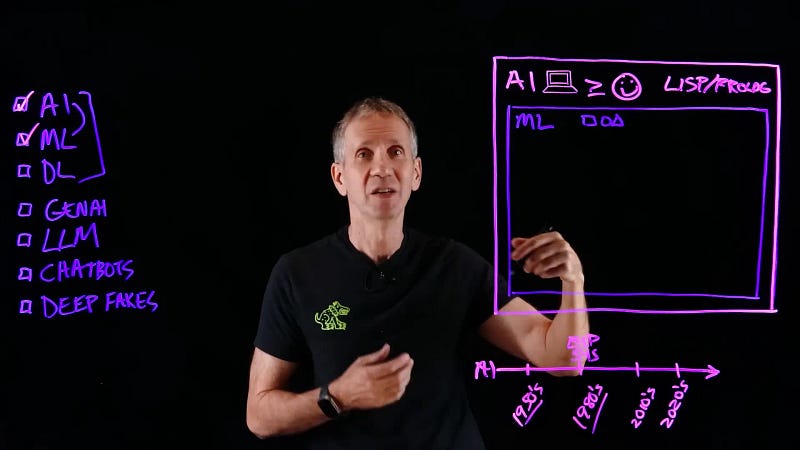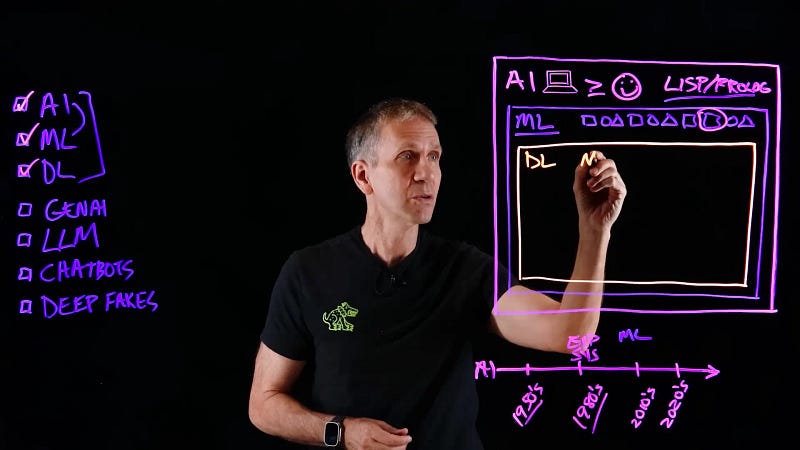Machine Learning Explained: Understanding AI, Deep Learning, and Generative AI
Machine Learning Explained: Artificial Intelligence (AI) has become one of the hottest topics today, with terms like machine learning and…

Machine Learning Explained: Artificial Intelligence (AI) has become one of the hottest topics today, with terms like machine learning and deep learning popping up everywhere. But what do these terms really mean? Are they the same, or are there important differences? And where does the recent surge of generative AI fit into all of this? Let’s dive into these concepts to clear up common myths and misunderstandings, and to explore how these technologies relate and impact our world.
Table of Contents
- What Is Artificial Intelligence (AI)?
- Machine Learning: When Machines Start Learning
- Deep Learning: Mimicking the Brain
- Generative AI and Foundation Models: The New Frontier
- The Evolution and Impact of AI Technologies
- Looking Ahead
- Get Started with AI Tools Today
What Is Artificial Intelligence (AI)?
At its core, artificial intelligence is about simulating human intelligence with computers — creating systems that can learn, infer, and reason like we do, or even better. But what exactly is intelligence? It’s a broad term, often defined as the ability to learn from experience, make inferences, and solve problems.

AI’s journey began decades ago as a research project, barely known outside academic circles. Early pioneers used programming languages like Lisp and Prolog to build what became known as expert systems — rule-based programs designed to mimic human expertise in specific domains. These systems gained popularity in the 1980s and 1990s, laying foundational work for what was to come.
Machine Learning: When Machines Start Learning
Machine learning (ML) is a subset of AI that focuses on algorithms that allow machines to learn from data rather than being explicitly programmed. Instead of hardcoding instructions, we feed these algorithms large amounts of data, and they identify patterns and make predictions.

Imagine showing a sequence of shapes to someone and asking them to predict the next shape. With limited examples, it’s tough to guess correctly. But with more exposure and practice, patterns become clearer. This is exactly how machine learning works — it improves its predictions as it processes more data.
Machine learning excels at two things:
- Predicting outcomes based on patterns — for example, forecasting the next word in a sentence or detecting fraudulent transactions.
- Spotting outliers — identifying unusual patterns that don’t fit, which is especially useful in areas like cybersecurity to flag suspicious user behavior.
Though machine learning has been around for decades, it really gained momentum and widespread adoption in the 2010s, transforming industries and powering many of the smart applications we use today.
Deep Learning: Mimicking the Brain
Deep learning is a specialized branch of machine learning inspired by the structure and function of the human brain. It uses neural networks, which are layers of algorithms designed to process data in ways that loosely resemble how neurons in our brains communicate.

Why “deep”? Because these networks have multiple layers that progressively extract higher-level features from raw data. This layer-by-layer approach allows deep learning models to tackle complex tasks like image recognition, natural language processing, and more.
One fascinating aspect of deep learning is its unpredictability. Just like human brains, these networks can produce surprising outputs, and sometimes even the engineers don’t fully understand why a model made a particular decision. This “black box” nature is both a challenge and a frontier for AI research.
Deep learning surged into the spotlight in the 2010s and remains a critical technology for advancing AI capabilities.
Generative AI and Foundation Models: The New Frontier
The most exciting recent advancements in AI come from the realm of generative AI. This technology focuses on creating new content — whether text, images, audio, or video — rather than just analyzing existing data.

A key concept here is foundation models, large-scale AI systems trained on vast amounts of data to understand and generate complex outputs. A prime example is large language models (LLMs), which can predict not just the next word, but entire sentences, paragraphs, or documents — think of it as an autocomplete on steroids.
Generative AI powers chatbots that can hold conversations, tools that create art, and even technologies that produce deepfakes — realistic but synthetic images or videos of people saying or doing things they never actually did. While deepfakes have entertaining and helpful uses, such as in parodies or restoring voices for people who have lost them, they also raise concerns about misuse.

Some critics argue that generative AI isn’t truly “creative,” suggesting it only recombines existing information. But consider music: every note already exists, yet musicians create new songs by combining those notes in fresh ways. Similarly, generative AI can produce genuinely new content by remixing knowledge in innovative forms.
The Evolution and Impact of AI Technologies
AI’s adoption started slowly — many people didn’t even know it existed, and those who did often thought it was perpetually “five to ten years away.” But with the rise of machine learning, deep learning, and now foundation models and generative AI, we’ve hit an inflection point.

Foundation models have changed the game, accelerating AI adoption across industries and everyday applications. From enhancing cybersecurity to powering virtual assistants and creative tools, AI technologies are reshaping how we work, communicate, and create.
Looking Ahead
Understanding the distinctions between AI, machine learning, deep learning, and generative AI helps us appreciate how these technologies fit together and where they’re headed. As AI continues to evolve, it’s crucial to stay informed, embrace the benefits, and thoughtfully address the challenges and ethical considerations that come with such powerful tools.
If you’re curious to explore more about AI agents, assistants, and the latest in AI technology, there are interactive demos and events that can deepen your knowledge and hands-on experience.
Machine learning explained clearly is the first step to unlocking the potential of AI in your personal and professional life.
Get Started with AI Tools Today
If you’re inspired by the potential of AI technologies like machine learning, deep learning, and generative AI, consider taking the next step by signing up for platforms that offer AI-powered tools and services. Create your account to explore interactive AI agents, assistants, and innovative applications that can enhance your personal and professional projects.
This article was based on the information provided from the video AI, Machine Learning, Deep Learning and Generative AI Explained




